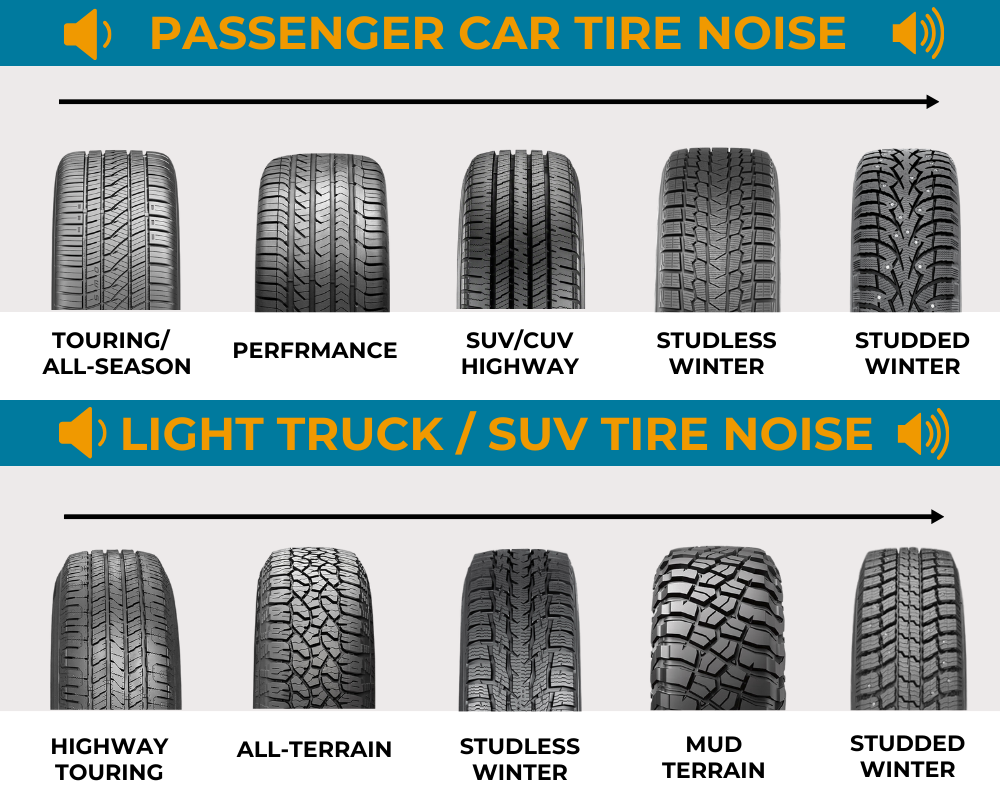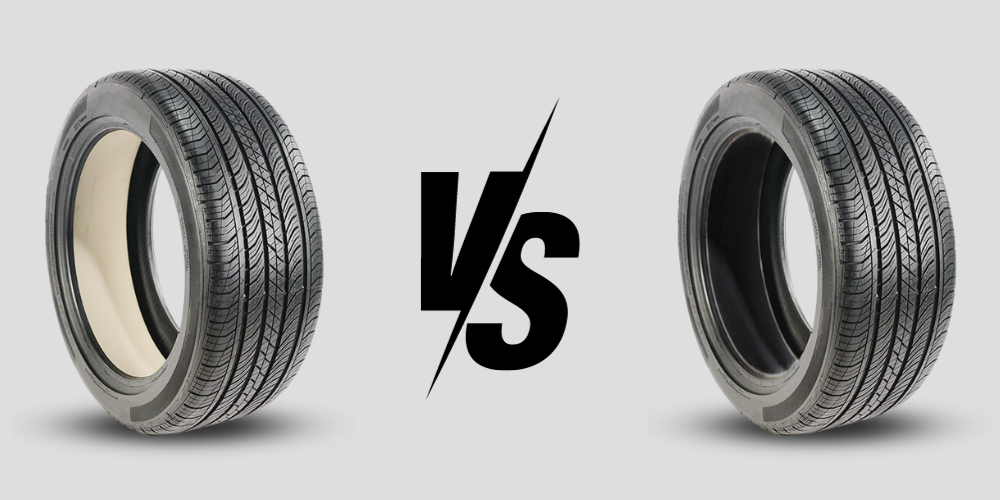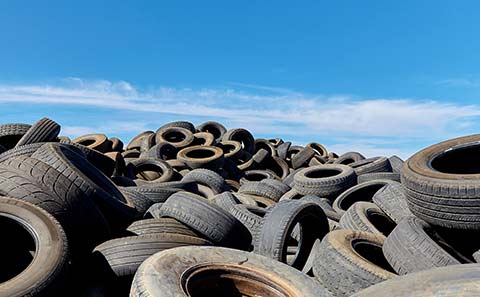Getting rid of excess road noise is crucial if you want to enjoy a relaxing experience while driving your car. With less noise in the car’s cabin, you can unwind a bit while driving home after a tiring day. Since there are so many factors in play, the reason behind that extra noise might not be obvious.
First off, we need to answer the following question: What are the tire characteristics that play a role in reducing tread noise? Once we identify them, we will have a clearer understanding of which factors actually cause tire noise.
Based on that knowledge, we are also going to share some easy tricks on how to reduce tire noise. You are also going to learn how exactly to choose new tires if you are looking for quiet ones. First, let’s see which characteristics have the biggest impact on tire sound quality.
Why Do Tires Make Road Noise?
Several things can cause loud tire noise at highway speeds. Although road noise is mostly generated by tires, a tire on the road is the only thing that can generate road noise. When a strange sound starts coming from your wheels, it indicates that something is wrong.
If you notice some additional noise when you change lanes, then it’s time to check your wheel bearings. Damaged wheel bearings are rather noisy. If you don’t change them in time, they can eventually cause serious damage.
You can find answers in this blog post on the questions of “Why do my tires hum so loud?”, “Why does my tire make noise when I drive?”, “Does tire pressure affect road noise?”. Let us walk you through a few problems that can cause loud road noise while driving and how to fix them.

Tire Rotation
New tires have exceptional grip and they are thicker than used ones. The optimized tread elements manage to grip the surfaces, but in some cases, you can end up with unevenly worn tires, which is a result of driving on versatile terrain surfaces.
With uneven wear, the tire’s tread depth is different on various tread sections. That is why the tires are loud. To prevent uneven wearing, you should regularly rotate tires every 5,000 miles. As a result, it will optimize the driving pressure distribution and make all four tires wear evenly.
Tire Pressure
Underinflated tires can generate additional noise as well, as it disrupts the tire’s road contact area. They increase the tire on-road area of the model during its performance. It means that the larger contact patch creates more noise as the bigger road-to-rubber ratio causes more friction.
This is one of the main problems that can be fixed by keeping your tires properly inflated. On your tire’s sidewall, you can find the recommended psi levels of the tire that are a good starting point.
Tire Balancing
Unbalanced tires can also cause tire noise when driving. The tire tread generates vibrations instead of balancing out the driving pressure along the footprint. This not only increases the tire’s noise levels but also makes the tread pattern wear out faster than it should – which significantly shortens the tire’s service life.
To prevent tire road noise caused by unbalanced tires, all you need to do is to get your tires balanced each time they are rotated and it will guarantee silence tires.
Uneven Tread Wear
If you can hear a loud tire sound during the drive, it can be caused by uneven wear as well. This is because contact between the tire and the road is uneven. The uneven tread pattern generates loud noises while driving, as the airflow through the footprint is irregular.
Usually, sounds caused by uneven wear only come from one tire. For example: if only your right tire makes noise when driving, it is definitely caused by irregular tread wear. Different uneven wear patterns can develop from various issues even related to inflation levels, tire rotations, and balancing.
Incorrect Tires
Knowing to choose the right tire for your vehicle is crucial for a quiet driving experience. If you mount an off-road or touring tire on your high speed performance vehicle, it can cause noise while the tires are in motion. These all terrain and touring tires have thicker and stronger rubber compounds than the performance tires which will generate extra sound waves at high speeds.
At the same time, off-road tires are also loud on the highway, because air passes through their aggressive tread patterns. All in all, not purchasing the right tire makes noise when driving, as each tire type is created for specific applications. So, if you want a quiet drive, be sure to buy the correct tire type for your vehicle.

Debris in the Tread
If debris gets stuck in the tire’s tread elements, it will make silence tires loud. It is really easy for small objects, such as rocks, sticks, and trash, to get stuck between the tread elements. When this happens, they can cause noise while you’re driving.
To reduce this annoying tire road noise, you just need to remove these objects from the tread. If the debris isn’t easily removable, it may have punched throughout the inner lining, which can cause a leak. When that happens, it is better to go to a tire shop or garage where the tires can be checked and fixed.
Quiet Tires – The New Norm to Fight Road Noise
We are all looking for the pleasant experience of a quieter ride when driving our vehicle. Noisy tires can easily distract or even annoy you and the other passengers in the car’s cabin. Fortunately, quiet tires are slowly but surely becoming the new norm.
Tire manufacturers, both big and small, are working on their own noise-reduction technologies. This makes them able to produce quieter tires and make them increasingly more affordable. Decreasing road noise from tires is now a standalone science that constantly evolves.
As more companies are figuring out the perfect tire features to reduce tire noise, the number of such tire models is on the rise in the market. Nowadays, everyone can get a quiet tire either online or at the local tire shop, and some of them are rather cheap.
How is a Tire Made to Reduce Road Noise?
Manufacturers consider several factors when designing noise-reducing tires. The typical tread pattern includes tire grooves, a narrow footprint, differently shaped tread blocks, fewer voids, and a semi-closed shoulder. By perfecting these characteristics, they can produce some of the quietest tires.
They invent noise-reducing technologies and combine them to minimize tire noise as much as possible. Nowadays, there are plenty of big brands out there working with high-end equipment to muster the most out of these technologies.
Road Noise Reducing Technology: Which are the Most Common?
The biggest companies have already figured out how to reduce tire tread vibrations at high speeds. They have set the standard by developing highly efficient technologies that help drivers experience quiet and comfortable rides.
Each of the big names in the industry invests millions into research to pioneer new tread designs. These reduce noise in the car’s interior by a great deal. Tire manufacturers rate their tires by a metric system that examines the performance and noise levels produced by one tire.
Below, we are going to show you some of the more general technologies that lower road noise from tires. Then, we are going to show you a couple of brand-specific technologies as well!
Variable Pitch on Tread Blocks
Manufacturers have figured out a highly effective way to guarantee a quiet ride. They started to design tires with special tread patterns that cancel out road noise. What they argued is that they can create particular patterns that generate sound frequencies that simply negate road noise.
After all, we are talking about sound waves that each have their own frequency. When two sound waves meet, they can cancel each other out. Their highs and lows need to negatively match each other at each point in time.
What Is Variable Tread Pitch?
A variable tread pitch is a particular tread design that features differently shaped and siped tread blocks. The main point here is to create a tread where the block sizes and the siping patterns vary along the footprint. In order for this to work, the tire has to have a uniform shape.
Due to this variability, the tire generates a different noise at every moment. When these noises sum up, they cancel each other out, resulting in a quiet ride. The noise coming from the tires barely reaches the car’s interior and it will be less noticeable to the human ear.
Popular Tire Insulation Technologies
Most popular manufacturers recognize the annoying tread and road noise issues, and they create tire technology that lowers tire noise when driving. They created a tire with foam inside to combat noise.
All tire manufacturers have their tire insulation technology for noise reduction, but mostly they are the same. They put a thick layer of foam covering the inner liner of the tire. These tires with foam inside significantly minimize the loud road noise while driving.
Additionally, manufacturers suggest mounting all four models with foam inside tires. These foam-lined tires can have different variations of color, width, style, and placement. Some acoustic tires have foam placed just partially, and some of them reach the entire footprint length.

Here are some of the most popular acoustic foam tires and their manufacturers:
The Pirelli Noise Canceling System
The PNCS is an advanced technology from the Italian tire brand Pirelli. Tire models that come with this system have a sound-absorbing device implemented. This can be found in the circumferential wall in their tires and it reduces noise by half as the tire rolls.
Inside the device, there is a sponge that absorbs vibrations and road noise coming from the tires. As a result, the tire-induced vibrations and sounds won’t affect the tire structure that much. This is how Pirelli’s tires improve the driver’s comfort.
Continental ContiSilent
ContiSilent is a well-known technology that Continental applies to many of its tire models. They claim to have reduced the road noise on all road surfaces and in all weather conditions. This technology does not change the tire’s performance characteristics and doesn’t affect the mileage or load capabilities either.
The fact that it does not affect the tires in any negative way makes it one of the leading acoustic tires technologies in the industry. Each of their tires with the ContiSilent technology has a polyurethane foam attached to the tread’s inner surface.
It is applied there with an adhesive that is not affected by the outside temperature.
Michelin Acoustic Technology
Michelin also has its own tech for reducing noise levels in the car interior. It is called the Michelin Acoustic Technology, claiming to produce 20% quieter tires. Just like Continental, their foam-lined tires use a polyurethane foam that absorbs road vibrations and noise.
This enables their tires to be driven in different surface conditions. Meanwhile, noise levels are low enough in the vehicle’s cabin so that you can enjoy the ride without being distracted. This is how Michelin keeps the sound levels low while developing top-performance tires.
Other Road Noise Decreasing Technologies
There are a number of lesser-known methods that significantly reduce the noise caused by tires or other sources. The methods we are going to talk about are super simple and you can try out all of them at home. For these, you don’t even need to touch your tires.
When it comes to noise reduction, you have two choices. You can either deal with the source of the noise or isolate the vehicle’s cabin from the noisy tires. After all, the goal is the same. You want a quieter ride, so you can focus on the road ahead without distractions.
Now, let’s delve into some DIY noise-reducing technologies!
Sound Deadening Mats
Soundproofing the car’s interior is a huge business right now. There are plenty of materials available out there that absorb outer noises with high efficiency. These can be applied to metal surfaces and working with them is not difficult at all.
All sound-deadening mats are made of a rubber compound that is especially dense. They are multi-functional, as they offer thermal insulation as well. In order to apply these materials, you need to remove your vehicle’s exterior too. The application does not require additional foam insulation.
If that’s something you feel like you can’t do by yourself, then it’s better to find an automotive shop where they do it for you. Once it’s all done, the noise intensity in your car will be approximately halved. The same method is widely used against engine noise as well.
High-Quality Door Seals
You can reduce road noise just by installing thick, high-quality door seals. Making sure that your doors are tightly shut is crucial if you want to enjoy a quiet ride. The slightest door seal gap can increase sound levels from various sources, not only from tires.
Changing the seals on the car doors is not that expensive and they can largely contribute to a quiet driving experience. Worn-out seals can also be repaired with some adhesive. In case you notice a minor crack, you can just apply weather strips to lower the noise.
Soundproofed Car Cabin Floor
The cabin floor of your vehicle is pretty close to the tire gears. Being so close to the noise source can result in elevated sound levels due to the transmission. This problem can be fixed by applying soundproofing material to the cabin floor.
Catching the sound waves can reduce road noise from tires by a great deal. The simplest way to go about it is to lay down rugs with thick material that absorbs noise. Soundproofing mats are highly efficient at reducing noise, which is why they are widely used in the sound-reduction world.
Thickened Wheel Wells
Wheel wells leave plenty of free space around your tires. They are the arches that surround them, providing some clearance around the wheels. You can turn this extra space to your advantage by using some sound-deadening material no matter the wheel size.
Since it is close to the tires, it significantly dampens the sound generated by them. As a result, there is less noise reaching the cabin. The two most popular materials for this purpose are the acoustic absorption foam and the mass-loaded vinyl.
Frequently Asked Questions
Do Tires Reduce Road Noise?
One way to reduce road noise is to keep them properly inflated. This can make a big difference, as underinflated tires have a larger contact patch. Due to their larger road-to-rubber ratio, they make more noise. You can fix this by checking the tire pressure once a month and fixing it.
Do Tires Make a Difference in Noise?
The tire’s tread design can make a huge difference in noise levels. Characteristics such as a narrow tread, fewer spaces between tread blocks, semi-closed shoulders, circumferential grooves, and smaller tread blocks can lower tire noise. Wide tires with open shoulders and big tread blocks are noisier.
Why Does My Tire Make Noise When I Drive?
Several issues can cause loud noise when driving. If I can hear my tires when driving, it can be caused by a few different factors related to tread pattern, tire pressure, and alignment. For example: uneven wear, alignment issues, and, also a wheel bearing that can cause loud tire noise at highway speeds.


